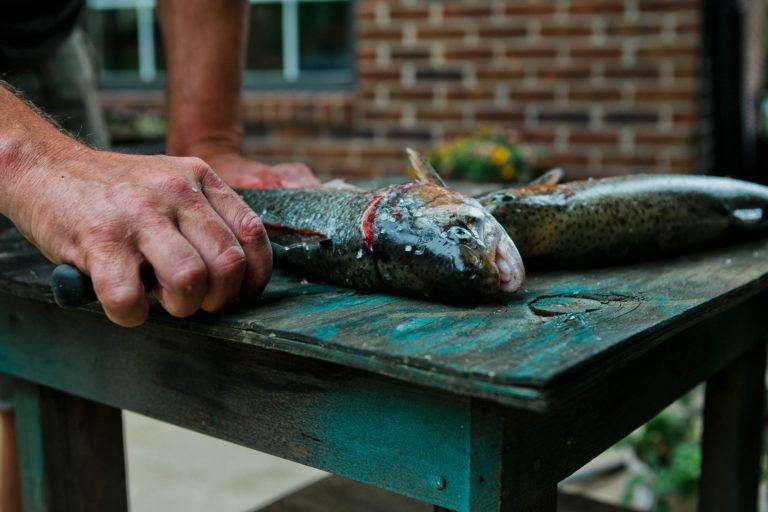
Quick Tips
- First, you'll need a sharp knife and a place to clean your fish.
- Place your knife just before the gills and cut down until you hit the spine.
- Once at the spine, turn the blade towards the tail and cut along the spine.
- Remove the ribcage from each fillet.
- Remove the scales/skin by pressing down at the tail end and sliding the blade under the flesh, against the scales/skin.
- Remove the line of small bones at the center of the fillets.
- Rinse the fish fillets and let them soak in cold water.
Learning to catch, clean, and prepare food is becoming rare as society moves further away from nature and the food we eat. Today, many parents would rather take their children to McDonald’s for fake-fish sandwiches than teach them how to get their own fresh, healthy fish from the water. Cleaning fish is a valuable life skill – one that is usually handed down from parents to their children. Perhaps your parents did other things with you, like watch TV. Don’t worry – it’s neither too hard nor too late to learn how to clean fish. I had to learn the craft to write this article. I learned – and so will you – from a true outdoorsman who boasts 55 years of experience cleaning fish (my father-in-law).
Of course, this outdoorsman would tell you that the fish cleaning method below isn’t the only way to do it. It’s how he does it. In my experience, the fish he prepares are disturbingly delicious and also free of bones. When he makes fish, I eat to the point of shame and embarrassment. This article will teach you how to fillet fish, which is how the vast majority of fish are cleaned. When starting out, don’t get discouraged. You will make a mess of your first few fish (I did) but it will get easier with each catch. Eventually you will be teaching others how to clean fish.
Steps to Cleaning Fish
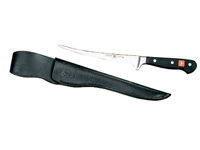 First, you’ll need a sharp knife and a place to clean your fish. Every tackle box needs a quality fillet knife. Sharpen it often; cleaning fish with a dull blade ruins the meat. Fishing lakes and resorts will usually have fish cleaning tables or a fish cleaning station near boat landings. We brought a cutting board along to clean fish on a natural rock landing. Important note: it is best to clean fish when they are fresh. Don’t let them die on the stringer before you harvest the meat.
First, you’ll need a sharp knife and a place to clean your fish. Every tackle box needs a quality fillet knife. Sharpen it often; cleaning fish with a dull blade ruins the meat. Fishing lakes and resorts will usually have fish cleaning tables or a fish cleaning station near boat landings. We brought a cutting board along to clean fish on a natural rock landing. Important note: it is best to clean fish when they are fresh. Don’t let them die on the stringer before you harvest the meat.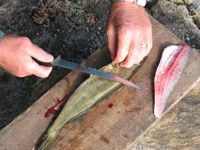 Place your knife just before the gills and cut down until you hit the spine. This takes a bit of practice. The dorsal fin marks half-way through the fish, and the spine will feel jagged against the blade. Still, even those with years of experience cleaning fish you will break through from time to time.
Place your knife just before the gills and cut down until you hit the spine. This takes a bit of practice. The dorsal fin marks half-way through the fish, and the spine will feel jagged against the blade. Still, even those with years of experience cleaning fish you will break through from time to time.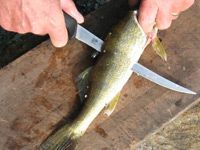 Once at the spine, turn the blade towards the tail and cut along the spine. The closer you cut to the spine, the more meat you’ll save. Once you have your first fillet, turn the fish over and repeat the previous two steps.
Once at the spine, turn the blade towards the tail and cut along the spine. The closer you cut to the spine, the more meat you’ll save. Once you have your first fillet, turn the fish over and repeat the previous two steps.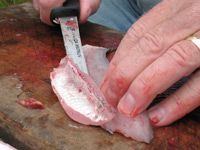 Remove the ribcage from each fillet. Insert the blade just beneath the ribs at the middle of the fillet. Guide the blade underneath the rib cage. The closer the cut, the more meat you’ll save. This is very hard for beginners, but don’t fret too much about this meat. Belly meat isn’t as good as the rest of the fillet and it sometimes exhibits the dreaded “fishy” taste.
Remove the ribcage from each fillet. Insert the blade just beneath the ribs at the middle of the fillet. Guide the blade underneath the rib cage. The closer the cut, the more meat you’ll save. This is very hard for beginners, but don’t fret too much about this meat. Belly meat isn’t as good as the rest of the fillet and it sometimes exhibits the dreaded “fishy” taste.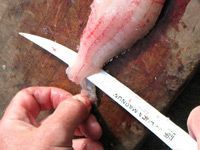 Remove the scales/skin by pressing down at the tail end and sliding the blade under the flesh, against the scales/skin. Once you are part way down the fillet you can get a better grip on the skin for leverage. You can use a slight angle to get tight against the scales, but don’t press too hard or you’ll go right through. If you are out on the lake, be sure to leave a small patch of scales on the fish for the DNR.
Remove the scales/skin by pressing down at the tail end and sliding the blade under the flesh, against the scales/skin. Once you are part way down the fillet you can get a better grip on the skin for leverage. You can use a slight angle to get tight against the scales, but don’t press too hard or you’ll go right through. If you are out on the lake, be sure to leave a small patch of scales on the fish for the DNR.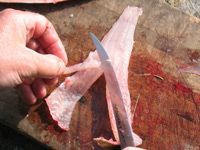 Remove the line of small bones at the center of the fillets. Not all fish will have this strip of bones, but walleye do. They are faint, but you’ll be able to feel them along the center of the fish. Cut a line along each side of these bones and remove the strip. The tedious parts of cleaning fish are now complete.
Remove the line of small bones at the center of the fillets. Not all fish will have this strip of bones, but walleye do. They are faint, but you’ll be able to feel them along the center of the fish. Cut a line along each side of these bones and remove the strip. The tedious parts of cleaning fish are now complete.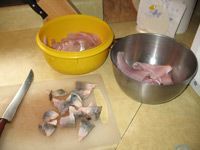 Rinse the fish fillets and let them soak in cold water.The cold soak should last an hour or two. This further cleans the fish and firms up the flesh. You have now learned how to clean fish like a master outdoorsman of 55 years. Freeze your catch if you like, but freshly caught fish are insanely delicious. You now know how to clean fish.
Rinse the fish fillets and let them soak in cold water.The cold soak should last an hour or two. This further cleans the fish and firms up the flesh. You have now learned how to clean fish like a master outdoorsman of 55 years. Freeze your catch if you like, but freshly caught fish are insanely delicious. You now know how to clean fish.
Clean Fish, Eat Fish
Scrumptious Fried Fish (Shore Lunch, olive oil, frying pan, one match, paper towels). After thawing your fish fillets, place them on clean paper towels to get rid of excess water (moist, not wet). Dump the Shore Lunch in a bread bag or plastic container, insert the fish fillets and shake while dancing. Have the burners at about medium high with a quarter inch of olive oil. Place one match in the oil. When the match ignites, the oil is at the perfect temperature for cooking the fillets. Oil that isn’t hot enough will make for soggy fillets. Oil that is too hot will start a fire. Fry the fillets until golden brown. Enjoy!
More on Cleaning Fish
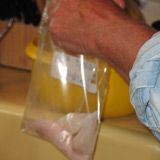 Ziploc bags.After you clean fish, you’ll probably eat some fresh and save the rest. Freezing fish fillets in Ziploc bags filled with water is the best method for saving fish. It keeps them fresh longer, protects them from freezer burn, and it’s handy. To thaw, just place the bag(s) in a bowl of water in the refrigerator the morning of or night before preparation. Fish frozen in this method are good for about one year, so be sure to write the date on each bag.
Ziploc bags.After you clean fish, you’ll probably eat some fresh and save the rest. Freezing fish fillets in Ziploc bags filled with water is the best method for saving fish. It keeps them fresh longer, protects them from freezer burn, and it’s handy. To thaw, just place the bag(s) in a bowl of water in the refrigerator the morning of or night before preparation. Fish frozen in this method are good for about one year, so be sure to write the date on each bag.
 Benefits of eating fish. Fish are an incredibly healthy, low-calorie source of protein. Many worry about mercury levels in fish, but researchers still advise two servings per week (unless you’re knocked up…then just one). Fish have been shown to reduce the incidence of heart disease, combat depression, improve skin health, relieve arthritis pain, and even prevent cancer. When fishing, keep moderate-sized fish; the older monsters contain more mercury.
Benefits of eating fish. Fish are an incredibly healthy, low-calorie source of protein. Many worry about mercury levels in fish, but researchers still advise two servings per week (unless you’re knocked up…then just one). Fish have been shown to reduce the incidence of heart disease, combat depression, improve skin health, relieve arthritis pain, and even prevent cancer. When fishing, keep moderate-sized fish; the older monsters contain more mercury.
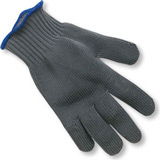 Fillet Glove.Cleaning fish presents a few dangers. Your fillet knife is oops-I-lost-a-finger sharp, and bony fish have fins that can cut too. Fillet gloves – part steel part yarn – will protect you from yourself…and the fish. They’re light and won’t hinder dexterity. Experienced fishermen use them, so rookies certainly should. You can get some good Rapala Fillet gloves from Amazon.
Fillet Glove.Cleaning fish presents a few dangers. Your fillet knife is oops-I-lost-a-finger sharp, and bony fish have fins that can cut too. Fillet gloves – part steel part yarn – will protect you from yourself…and the fish. They’re light and won’t hinder dexterity. Experienced fishermen use them, so rookies certainly should. You can get some good Rapala Fillet gloves from Amazon.